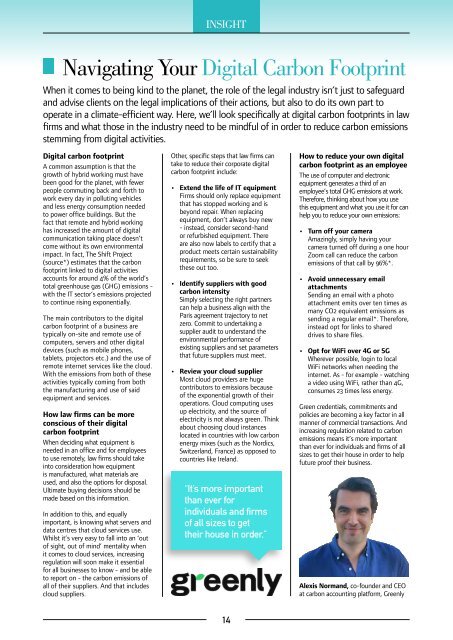Modern Law Magazine Issue 67
You also want an ePaper? Increase the reach of your titles
YUMPU automatically turns print PDFs into web optimized ePapers that Google loves.
INSIGHT<br />
INSIGHT<br />
Navigating Your Digital Carbon Footprint<br />
When it comes to being kind to the planet, the role of the legal industry isn’t just to safeguard<br />
and advise clients on the legal implications of their actions, but also to do its own part to<br />
operate in a climate-efficient way. Here, we’ll look specifically at digital carbon footprints in law<br />
firms and what those in the industry need to be mindful of in order to reduce carbon emissions<br />
stemming from digital activities.<br />
Digital carbon footprint<br />
A common assumption is that the<br />
growth of hybrid working must have<br />
been good for the planet, with fewer<br />
people commuting back and forth to<br />
work every day in polluting vehicles<br />
and less energy consumption needed<br />
to power office buildings. But the<br />
fact that remote and hybrid working<br />
has increased the amount of digital<br />
communication taking place doesn’t<br />
come without its own environmental<br />
impact. In fact, The Shift Project<br />
(source*) estimates that the carbon<br />
footprint linked to digital activities<br />
accounts for around 4% of the world’s<br />
total greenhouse gas (GHG) emissions -<br />
with the IT sector’s emissions projected<br />
to continue rising exponentially.<br />
The main contributors to the digital<br />
carbon footprint of a business are<br />
typically on-site and remote use of<br />
computers, servers and other digital<br />
devices (such as mobile phones,<br />
tablets, projectors etc.) and the use of<br />
remote internet services like the cloud.<br />
With the emissions from both of these<br />
activities typically coming from both<br />
the manufacturing and use of said<br />
equipment and services.<br />
How law firms can be more<br />
conscious of their digital<br />
carbon footprint<br />
When deciding what equipment is<br />
needed in an office and for employees<br />
to use remotely, law firms should take<br />
into consideration how equipment<br />
is manufactured, what materials are<br />
used, and also the options for disposal.<br />
Ultimate buying decisions should be<br />
made based on this information.<br />
In addition to this, and equally<br />
important, is knowing what servers and<br />
data centres that cloud services use.<br />
Whilst it’s very easy to fall into an ‘out<br />
of sight, out of mind’ mentality when<br />
it comes to cloud services, increasing<br />
regulation will soon make it essential<br />
for all businesses to know - and be able<br />
to report on - the carbon emissions of<br />
all of their suppliers. And that includes<br />
cloud suppliers.<br />
Other, specific steps that law firms can<br />
take to reduce their corporate digital<br />
carbon footprint include:<br />
• Extend the life of IT equipment<br />
Firms should only replace equipment<br />
that has stopped working and is<br />
beyond repair. When replacing<br />
equipment, don’t always buy new<br />
- instead, consider second-hand<br />
or refurbished equipment. There<br />
are also now labels to certify that a<br />
product meets certain sustainability<br />
requirements, so be sure to seek<br />
these out too.<br />
• Identify suppliers with good<br />
carbon intensity<br />
Simply selecting the right partners<br />
can help a business align with the<br />
Paris agreement trajectory to net<br />
zero. Commit to undertaking a<br />
supplier audit to understand the<br />
environmental performance of<br />
existing suppliers and set parameters<br />
that future suppliers must meet.<br />
• Review your cloud supplier<br />
Most cloud providers are huge<br />
contributors to emissions because<br />
of the exponential growth of their<br />
operations. Cloud computing uses<br />
up electricity, and the source of<br />
electricity is not always green. Think<br />
about choosing cloud instances<br />
located in countries with low carbon<br />
energy mixes (such as the Nordics,<br />
Switzerland, France) as opposed to<br />
countries like Ireland.<br />
“It’s more important<br />
than ever for<br />
individuals and firms<br />
of all sizes to get<br />
their house in order.”<br />
How to reduce your own digital<br />
carbon footprint as an employee<br />
The use of computer and electronic<br />
equipment generates a third of an<br />
employee’s total GHG emissions at work.<br />
Therefore, thinking about how you use<br />
this equipment and what you use it for can<br />
help you to reduce your own emissions:<br />
• Turn off your camera<br />
Amazingly, simply having your<br />
camera turned off during a one hour<br />
Zoom call can reduce the carbon<br />
emissions of that call by 96%*.<br />
• Avoid unnecessary email<br />
attachments<br />
Sending an email with a photo<br />
attachment emits over ten times as<br />
many CO2 equivalent emissions as<br />
sending a regular email*. Therefore,<br />
instead opt for links to shared<br />
drives to share files.<br />
• Opt for WiFi over 4G or 5G<br />
Wherever possible, login to local<br />
WiFi networks when needing the<br />
internet. As - for example - watching<br />
a video using WiFi, rather than 4G,<br />
consumes 23 times less energy.<br />
Green credentials, commitments and<br />
policies are becoming a key factor in all<br />
manner of commercial transactions. And<br />
increasing regulation related to carbon<br />
emissions means it’s more important<br />
than ever for individuals and firms of all<br />
sizes to get their house in order to help<br />
future proof their business.<br />
Alexis Normand, co-founder and CEO<br />
at carbon accounting platform, Greenly<br />
The Green Machine<br />
In our tech-centric world, electronic devices have become our faithful companions. From<br />
the moment we wake to our smartphone alarms, to the late-night Netflix binge on our<br />
smart TVs, technology is ever-present. But there’s a dark side to this relentless innovation:<br />
a colossal pile of electronic waste (e-waste), which takes up valuable space and poses a<br />
significant environmental threat.<br />
Our electronic devices have a significant<br />
impact on our environment. The process<br />
of manufacturing a single desktop<br />
computer requires around 539 pounds<br />
of fossil fuels, 48 pounds of chemicals,<br />
and at least 1.5 tons of water. That’s<br />
a staggering number of resources for<br />
just one piece of technology. But it<br />
doesn’t stop there. The production<br />
process generates roughly 150 kgs<br />
of greenhouse gases. Inside your<br />
electronics are rare Earth materials such<br />
as gold, silver, copper, and cobalt. These<br />
resources have limited supplies and are<br />
often hazardous to extract.<br />
So, what’s the answer to this growing<br />
problem? Recycling and Reuse. When<br />
we recycle our electrical equipment,<br />
we reduce its negative effect on the<br />
environment significantly. Creating a more<br />
eco-conscious and circular life cycle for<br />
technology is vital for protecting the planet<br />
from the harmful materials in our devices.<br />
The number of electrical items that get<br />
thrown away is constantly growing, and<br />
currently, only 17.5% of this waste is<br />
recycled appropriately. When we recycle<br />
our old devices, the precious materials<br />
can be extracted and reused, meaning<br />
that we don’t need to mine for more. It<br />
also stops more greenhouse gases from<br />
entering the atmosphere.<br />
Meet Natalie King-Barnard, Head of<br />
Sales and Marketing at Green Machine<br />
Computers. For 12 years, they’ve been<br />
on a mission to protect the environment<br />
and tackle digital poverty by helping<br />
businesses dispose of obsolete IT<br />
equipment securely. The Wiltshire-based<br />
recycling facility is committed to proper<br />
e-waste recycling and disposal. Their<br />
accreditations are proof that they handle<br />
both data and waste materials in a safe<br />
and environmentally friendly way. They<br />
repair and reuse absolutely everything<br />
possible (down to screws and office<br />
furniture), and partner with a number<br />
of charities to rehome useful hardware.<br />
Working with a refinery, they break down<br />
irreparable IT equipment to their core<br />
materials, so that these can be melted<br />
down and reused.<br />
This process liberates office space and<br />
maintains GDPR compliance while<br />
lowering carbon emissions and ensuring<br />
these devices benefit less fortunate<br />
individuals. Green Machine Computers,<br />
with its customers’ help, has cut CO2<br />
emissions by 13,500 metric tonnes in<br />
the last five years. That’s equivalent<br />
to powering 1,701 homes for a year.<br />
This isn’t just about numbers; it’s a<br />
commitment to sustainability. The<br />
dedicated team tests, repairs and reuses<br />
every useable component from the<br />
devices collected, ensuring that nothing<br />
goes to waste. Moreover, Green Machine<br />
Computers offers customers a clear<br />
breakdown of their CO2 savings.<br />
But what about your data? Many<br />
businesses worry about recycling their<br />
devices because of the data they<br />
contain. However, recycling companies<br />
like Green Machine take data security<br />
extremely seriously. They wipe all the<br />
data from every device they recycle as<br />
standard and can provide certificates to<br />
prove this along with a full audit trail of<br />
what has been collected.<br />
Instead of trashing perfectly functional<br />
devices, Green Machine Computers<br />
specialises in refurbishing and<br />
extending the lifespan of electronic<br />
equipment. While collecting and<br />
diverting this equipment, they’ve<br />
been able to refurbish thousands of<br />
devices which have then been donated<br />
to schools, charities and non-profit<br />
organisations across the UK. Green<br />
Machine Computers recognise the<br />
social inequalities perpetuated by the<br />
‘digital divide’. Through partnerships<br />
with schools, charities, and non-profit<br />
organisations, they donate refurbished<br />
devices to disadvantaged communities.<br />
By securely wiping and restoring<br />
unwanted technology, the team can<br />
rehome devices with people in need<br />
who can utilise them for educational,<br />
employment, and social opportunities.<br />
“As our world<br />
continues to<br />
go digital, our<br />
responsibilities<br />
grow.”<br />
So far, their donations have supported<br />
a wide variety of people, from refugees<br />
to local youth groups, from women’s<br />
shelters to children’s hospices. Their<br />
work has ensured that all of that ‘waste’,<br />
has not been wasted.<br />
As our world continues to go digital,<br />
our responsibilities grow. Green<br />
Machine Computers proves that<br />
tackling e-waste is a collective<br />
responsibility to build a sustainable<br />
future for the technology industry.<br />
Natalie King-Barnard, Head of<br />
Sales and Marketing, Green Machine<br />
Computers.<br />
14 15
















